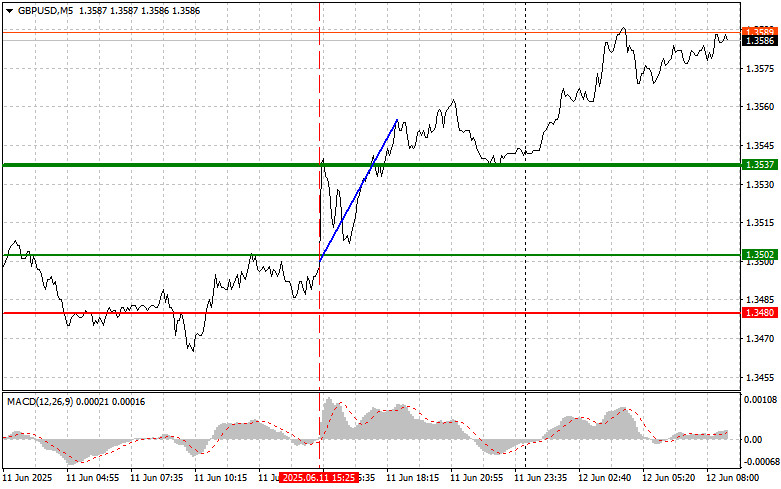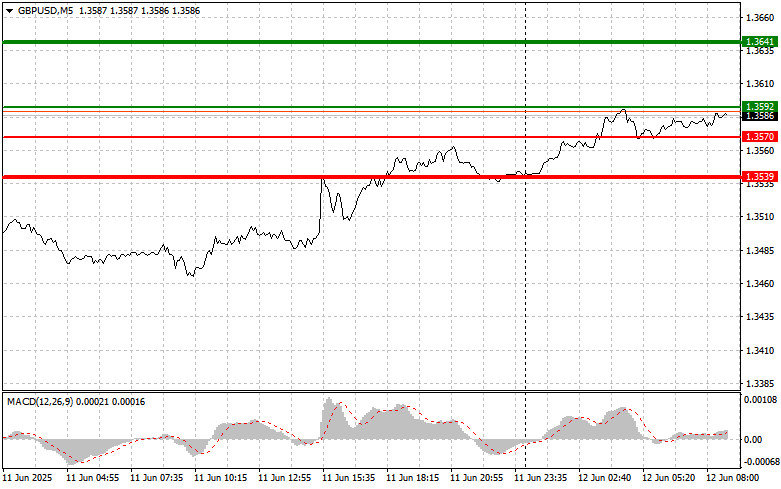Analysis of Trades and Trading Tips for the British Pound
The price test at 1.3502 occurred when the MACD indicator had just begun rising from the zero line, confirming the validity of the entry point for purchasing the pound and resulting in a 50-pip rally.
News that U.S. inflation came in lower than economists had expected triggered a decline in the U.S. dollar and strengthened the pound. This sudden shift in the currency market sparked a wave of optimism among investors, who now believe the Federal Reserve may resume interest rate cuts. The pound's strengthening was a welcome surprise for the UK economy, which has recently faced significant challenges. A stronger currency can help reduce inflationary pressure, lower import costs, and support economic growth.
As for the economic outlook, upcoming data on the UK's GDP, industrial production, and manufacturing output is expected. Weak figures will quickly put renewed pressure on the pair. If the results disappoint, concerns over a deeper UK recession will grow, immediately impacting the pound's exchange rate. Selling pressure will intensify, and the pound's recovery prospects will become more uncertain. Speculators are likely to seize the opportunity to open short positions.
On the other hand, surprisingly strong data could support the pound, boosting the pair's continued recovery. The Bank of England will be faced with a difficult decision regarding monetary policy—balancing the need to combat inflation with the risk of stalling economic growth. Today promises to be a volatile session for the pound, and the outcome will largely depend on the released data.
For intraday strategy, I will focus primarily on Scenarios #1 and #2.
Buy Scenario
Scenario #1: I plan to buy the pound today at an entry point near 1.3592 (green line on the chart) with a target at 1.3641 (thicker green line). Around 1.3641, I will exit the long position and initiate a short position, expecting a 30–35 pip pullback from the level. A rise in the pound can be expected after strong economic data.
Important! Before buying, ensure the MACD indicator is above the zero line and beginning to rise.
Scenario #2: I also plan to buy the pound today in the event of two consecutive tests of the 1.3570 level when the MACD is in oversold territory. This would limit the pair's downside potential and lead to a reversal upward. In this case, a rise toward the opposite levels of 1.3592 and 1.3641 is expected.
Sell Scenario
Scenario #1: I plan to sell the pound after a break below 1.3570 (red line on the chart), which would result in a sharp decline of the pair. The key target for sellers will be 1.3539, where I intend to exit the short position and open a long immediately in the opposite direction (expecting a 20–25 pip rebound from the level). Selling the pound will be reasonable after weak GDP data.
Important! Before selling, make sure the MACD indicator is below the zero line and starting to decline from it.
Scenario #2: I also plan to sell the pound today in the event of two consecutive tests of the 1.3592 level while the MACD is in overbought territory. This would cap the pair's upside potential and lead to a market reversal downward. In this case, I expect a decline toward the support levels of 1.3570 and 1.3539.
What's on the Chart:
- The thin green line represents the entry price where the trading instrument can be bought.
- The thick green line indicates the expected price level where a Take Profit order can be placed, or profits can be manually secured, as further price growth above this level is unlikely.
- The thin red line represents the entry price where the trading instrument can be sold.
- The thick red line indicates the expected price level where a Take Profit order can be placed, or profits can be manually secured, as further price decline below this level is unlikely.
- The MACD indicator should be used to assess overbought and oversold zones when entering the market.
Important Notes:
- Beginner Forex traders should exercise extreme caution when making market entry decisions. It is advisable to stay out of the market before the release of important fundamental reports to avoid exposure to sharp price fluctuations. If you choose to trade during news releases, always use stop-loss orders to minimize potential losses. Trading without stop-loss orders can quickly wipe out your entire deposit, especially if you neglect money management principles and trade with high volumes.
- Remember, successful trading requires a well-defined trading plan, similar to the one outlined above. Making impulsive trading decisions based on the current market situation is a losing strategy for intraday traders.














